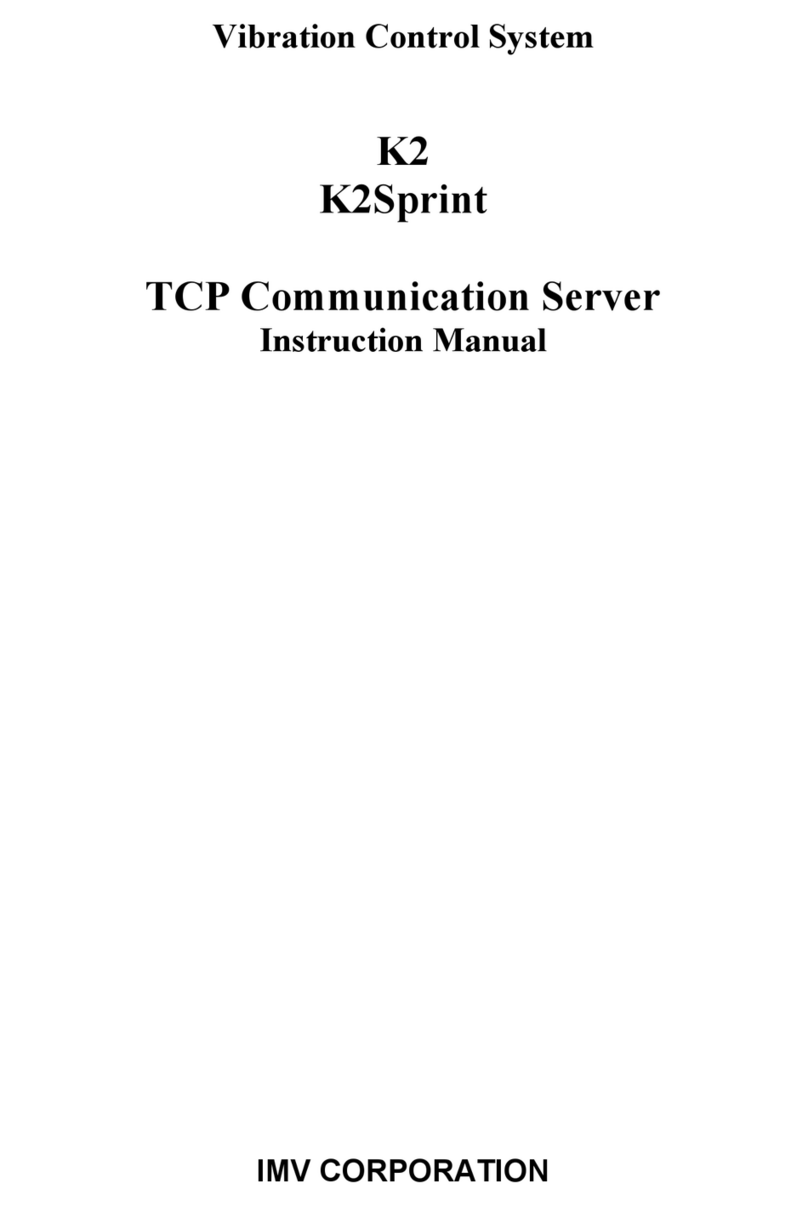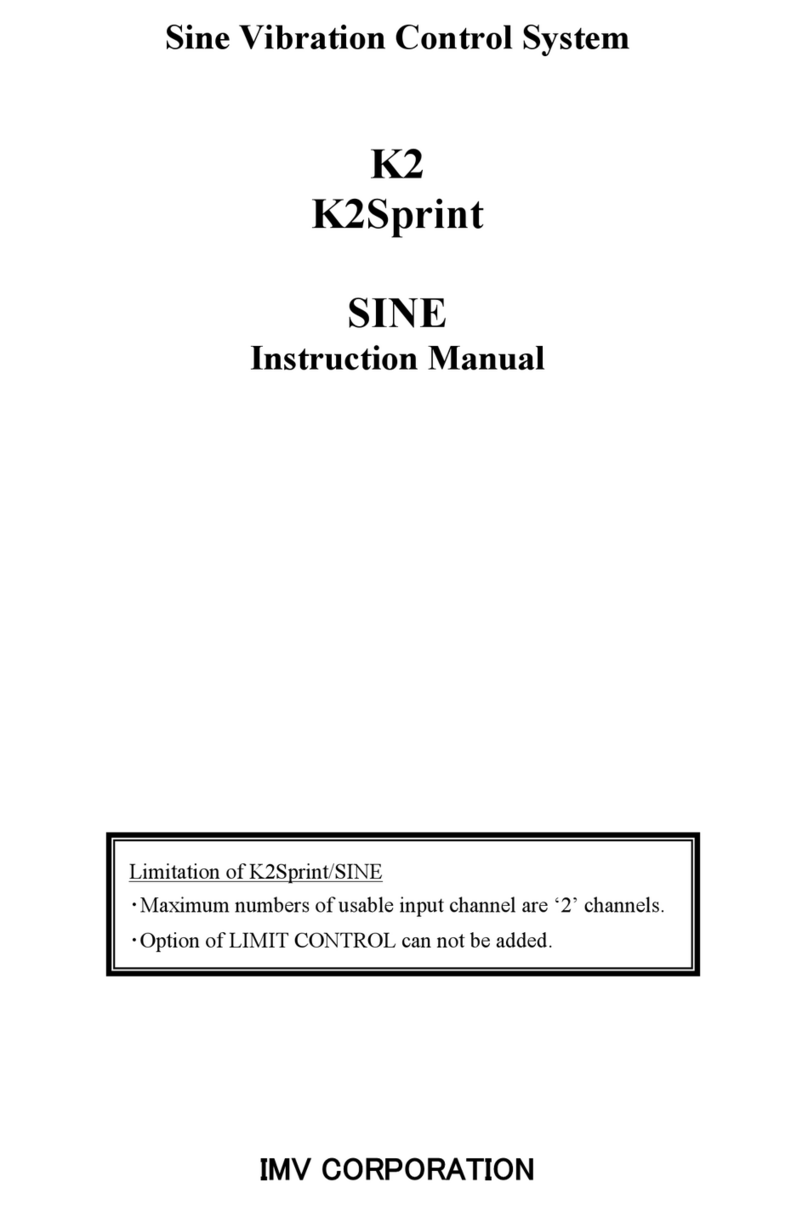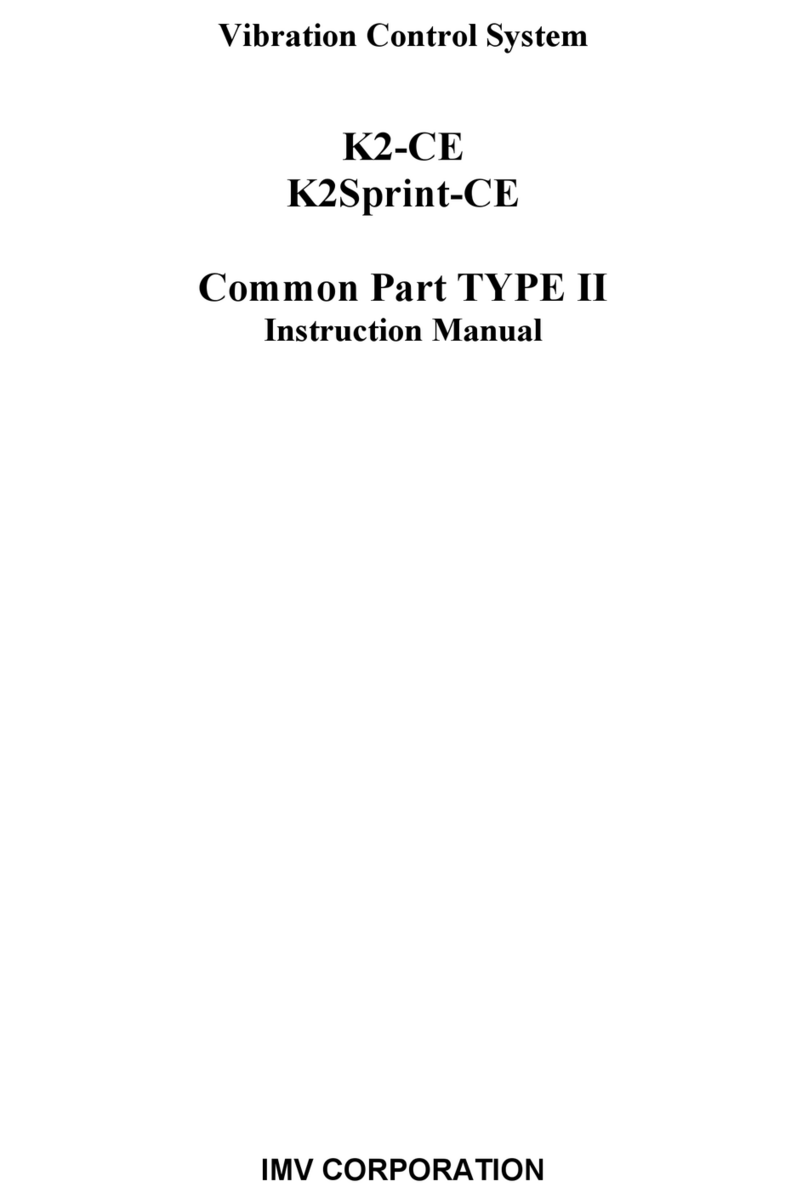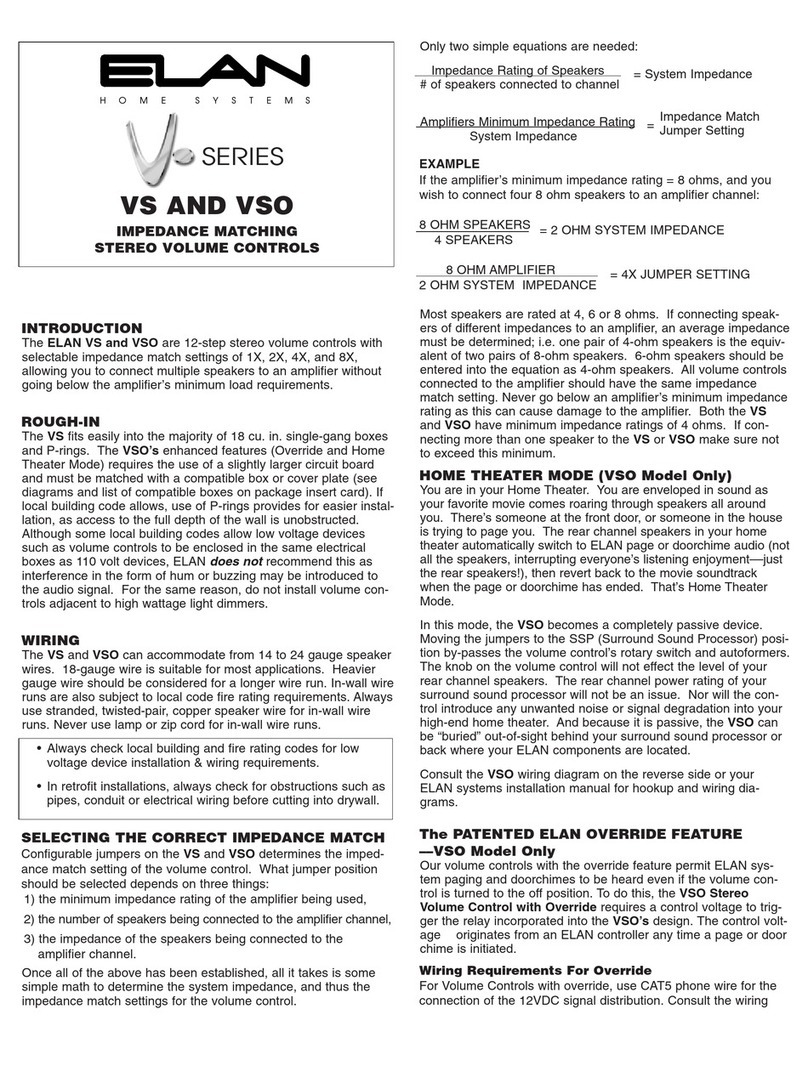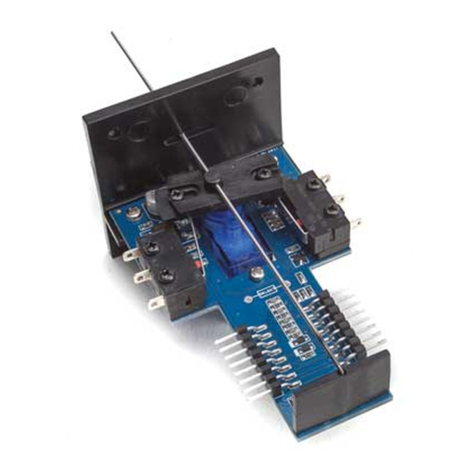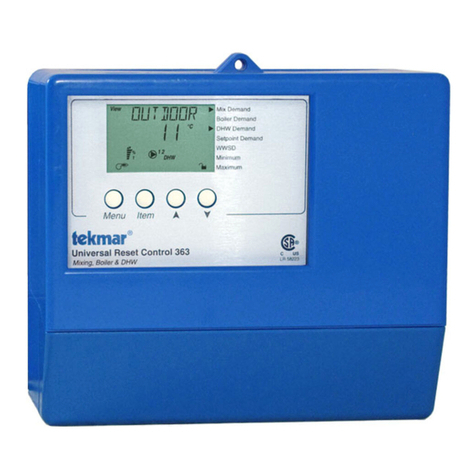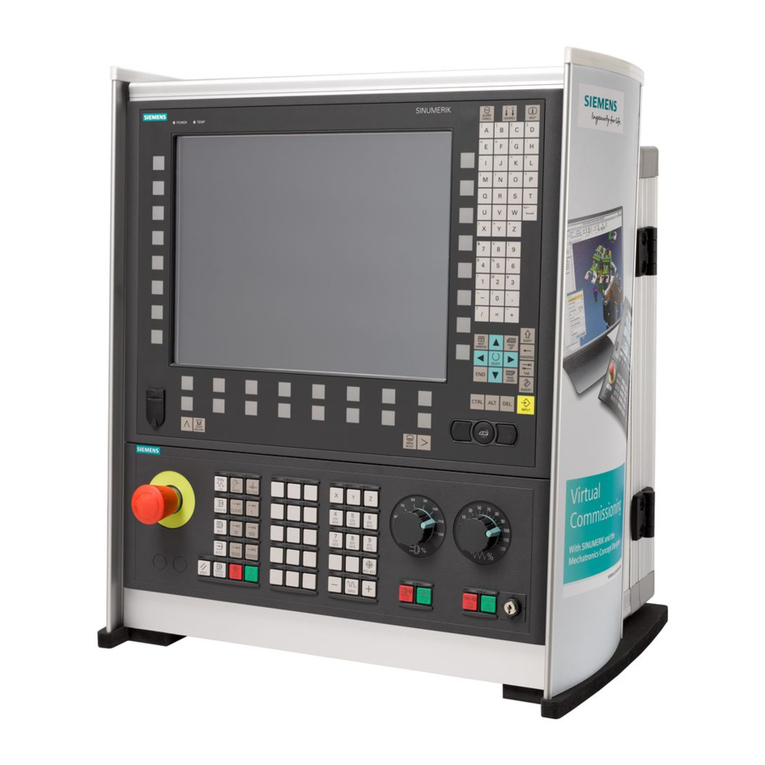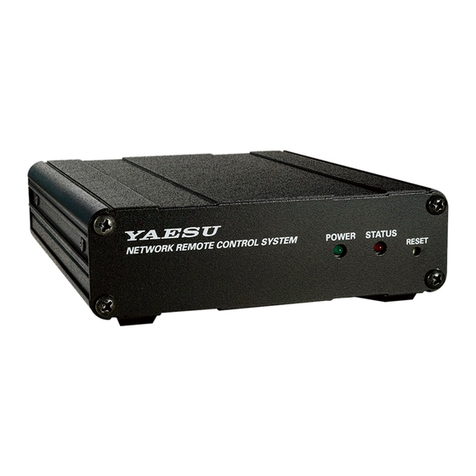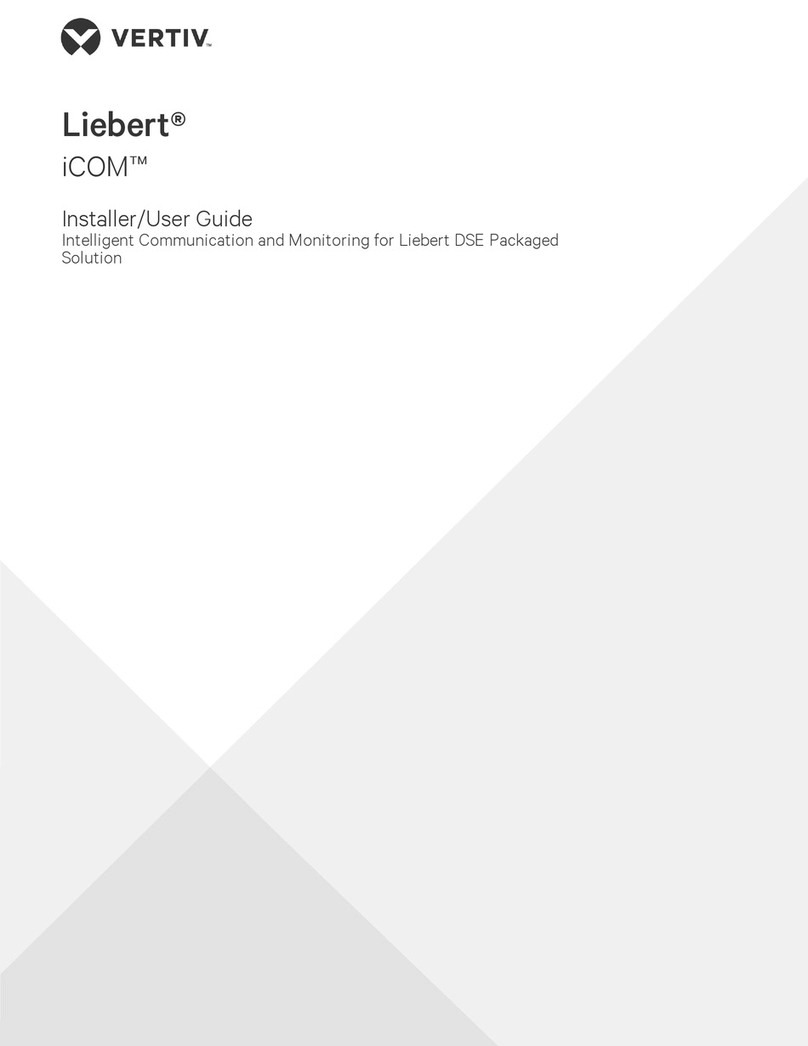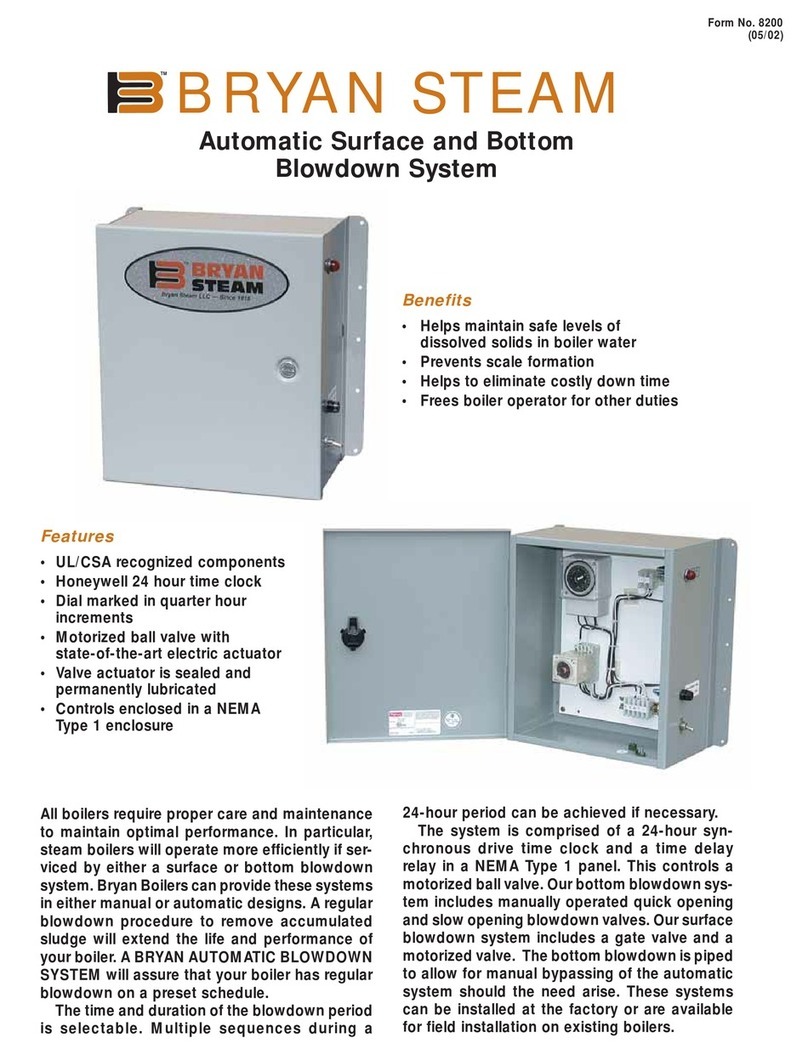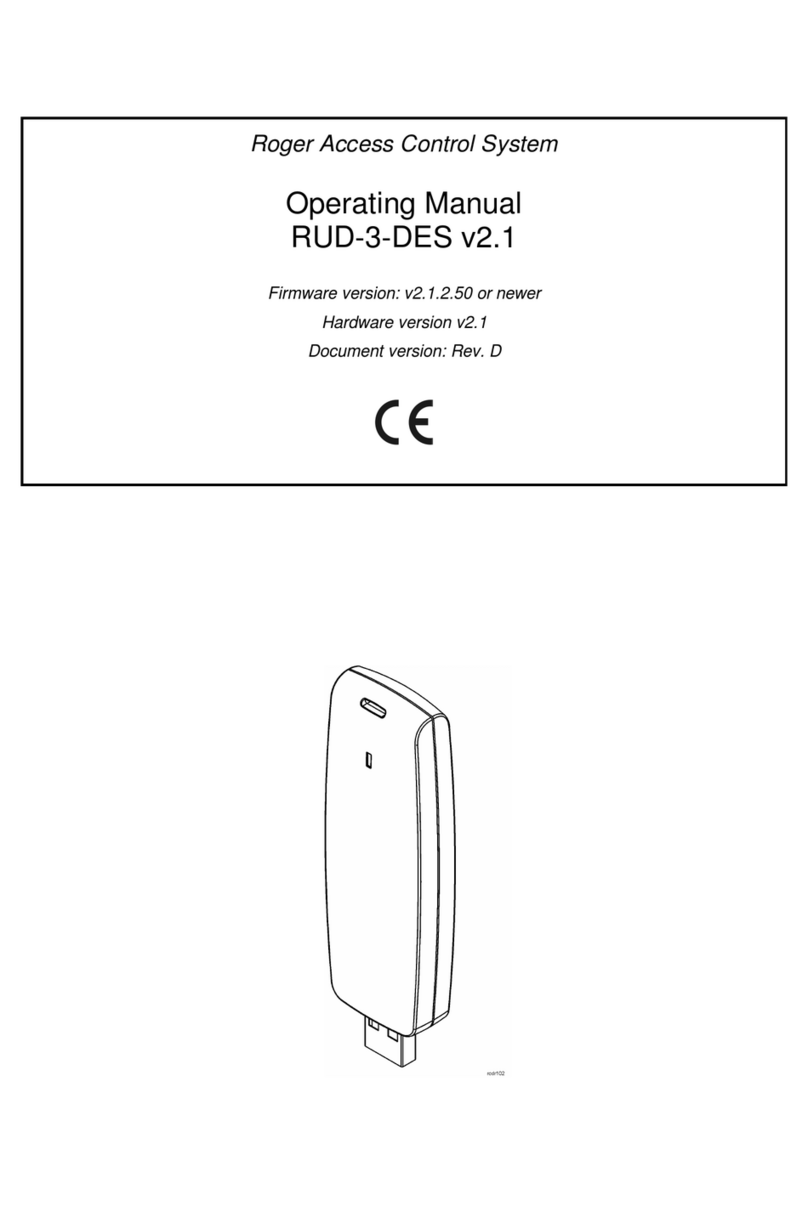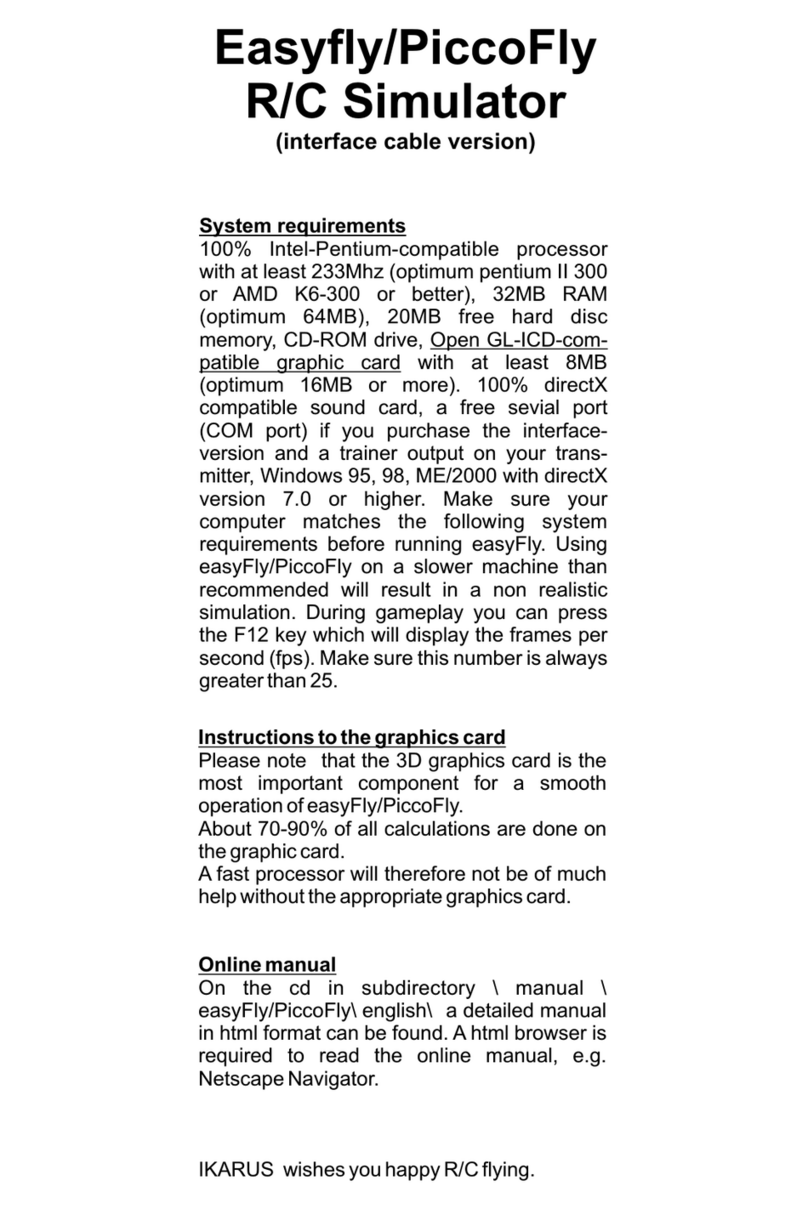IMV K2 User manual

Random Vibration Control System
K2
K2Sprint
RANDOM
Instruction Manual
IMV CORPORATION
ULimitation of K2Sprint/RANDOM
・Maximum numbers of usable input channel are ‘2’ channels.
・Option of LIMIT CONTROL can not be added.

Type of Document : Instruction Manual
System Applied : K2/K2Sprint
Software < RANDOM, SOR/ROR > Later than Version 20.1.0

Japanese Edition
Version Date Contents
1.0.0 2004.01.30 First edition
1.0.1 2004.04.02 Correction of a misprint
2.0.0 2004.08.10 Additional descriptions of Simplified Definition, and Level Schedule function.
3.0.0 2005.03.31 Additional description of “Transmissibility display unit”, “Excitation level
mode” in Setup and “Observation freq. can be set within the Reference freq.
range”.
3.0.1 2008.01.18 Correction of a misprint
3.1.0 2008.12.17 Additional description of CSV data file.
6.0.0 2010.10.21 Applied to Windows7
6.1.0 2011.09.26 Additional description of “Minimum value control”
6.2.0 2012.02.29 Additional description of level selection for periodical saving file of Data save
conditions
10.0.0 2013.08.09 Renewal of screen display, modification of the upper limit of the number of
control lines, addition of amplitude probability density to the data to display,
modified description of test files, additional description of input channels and
additional description of operation settings (display config for operation)
13.5.0 2017.06.27 Additional description of ‘Response data save’ in Setup, additional description
of loop check detailed settings
14.0.0 2018.01.31 Additional description of ‘Extended random on random option’, addition of
amplitude probability density analysis
14.1.0 2018.04.27 Additional description of Measured waveform definition
14.3.0 2019.04.19 Additional description of “Safety check”, modified description of Data save
condition, correction of misprints
14.3.1 2019.06.18 Modified description of “High Pass Filter(HPF)”
14.5.0 2019.12.27 Additional description of ‘Soft-Clipping option’ and ‘Aux Output’
20.1.0 2021.01.28 Additional description of ‘Pause before transitioning to "In excitation"’ of
‘Fundamental/Control Condition’ and ‘Reset timer at 0dB’ of ‘Data Save
Condition’.
Additional description of ‘Clear history at operation start’ and ‘Set the data
file name automatically’ of ‘Set up’.
Correction of a misprint.

English Edition
Version Date Contents
1.0.1 2004.04.02 First edition, Correction of a misprint
2.0.0 2004.08.19 Additional descriptions of Simplified Definition, and Level Schedule function.
3.0.0 2005.04.06 Additional description of “Transmissibility display unit”, “Excitation level
mode” in Setup and “Observation freq. can be set within the Reference freq.
range”.
3.0.1 2008.01.18 Correction of a misprint
3.1.0 2010.02.25 Additional description of CSV data file.
6.0.0 2010.11.05 Applied to Windows7
6.1.0 2011.09.26 Additional description of “Minimum value control”
6.2.0 2012.02.29 Additional description of level selection for periodical saving file of Data save
conditions
10.0.0 2013.08.09 Renewal of screen display, modification of the upper limit of the number of
control lines, addition of amplitude probability density to the data to display,
modified description of test files, additional description of input channels and
additional description of operation settings (display config for operation)
13.5.0 2017.10.02 Additional description of ‘Response data save’ in Setup, additional description
of loop check detailed settings
14.0.0 2018.01.31 Additional description of ‘Extended random on random option’, addition of
amplitude probability density analysis
14.1.0 2018.04.27 Additional description of Measured waveform definition
14.3.0 2019.04.19 Additional description of “Safety check”, modified description of Data save
condition, correction of misprints
14.3.1 2019.06.18 Modified description of “High Pass Filter(HPF)”
14.5.0 2019.12.27 Additional description of ‘Soft-Clipping option’ and ‘Aux Output’
20.1.0 2021.01.28 Additional description of ‘Pause before transitioning to "In excitation"’ of
‘Fundamental/Control Condition’ and ‘Reset timer at 0dB’ of ‘Data Save
Condition’.
Additional description of ‘Clear history at operation start’ and ‘Set the data
file name automatically’ of ‘Set up’.
Correction of a misprint.

CONTENS
Chapter 1 Outline of the System........................................................... 1-1
1.1 Specifications .................................................................... 1-1
1.1.1 RANDOM ...................................................................... 1-1
1.1.2 Sine On Random (Option of RANDOM) ........................................... 1-3
1.1.3 Random On Random (Option of RANDOM) ......................................... 1-4
1.1.3.1 Extended Random On Random (Option of Random On Random) ................ 1-5
1.1.4 PSD Limit (Option of RANDOM) ................................................ 1-5
1.1.5 Non Gaussian (Option of RANDOM) ............................................. 1-5
1.1.6 Soft-Clipping (Option of RANDOM) ............................................ 1-6
Chapter 2 Operation System of K2 Application.............................................. 2-1
2.1 Outline ........................................................................... 2-1
2.2 Test File ......................................................................... 2-2
2.3 Test Type ......................................................................... 2-3
Chapter 3 Basic Operation................................................................. 3-1
3.1 Random Test ....................................................................... 3-1
3.2 Simplified Definition ............................................................. 3-22
Chapter 4 Test Definition................................................................. 4-1
4.1 Outline ........................................................................... 4-1
4.2 Fundamental/Control Condition ..................................................... 4-2
4.2.1 Frequency range fmax ........................................................ 4-2
4.2.2 Control frequency lines ..................................................... 4-2
4.2.3 Max. Observation Frequency (Max. Observation Freq.) ......................... 4-3
4.2.4 Controlled variable ......................................................... 4-3
4.2.5 Averaging Parameters ........................................................ 4-4
4.2.6 Equalization Mode ........................................................... 4-5
4.2.7 Loop check .................................................................. 4-5
4.2.7.1 Ambient noise upper limit ............................................. 4-6
4.2.7.2 Transmissibility check value [in initial excitation] .................. 4-6
4.2.7.3 Transmissibility check value [in test operation] ...................... 4-7
4.2.7.4 Overload check value .................................................. 4-7
4.2.8 Test time ................................................................... 4-7
4.2.9 Initial output level ........................................................ 4-7
4.2.10 Level increment ............................................................ 4-8
4.2.11 Auto-start ................................................................. 4-8
4.2.12 Shutdown time .............................................................. 4-8
4.2.13 Level Scheduling ........................................................... 4-9
4.2.13.1 Level ................................................................ 4-10
4.2.13.2 Time ................................................................. 4-10

4.2.13.3 Tolerance Enlarge.................................................... 4-10
4.2.14 Observation freq. can be set within the Reference freq. range .............. 4-11
4.2.15 Pause before transitioning to "In excitation" .............................. 4-11
4.3 Excitation System Setting ......................................................... 4-12
4.3.1 Initial output voltage ...................................................... 4-12
4.3.2 Clipping.................................................................... 4-12
4.3.2.1 Clipping by crest factor.............................................. 4-12
4.3.2.2 Output voltage limit value............................................ 4-13
4.3.2.3 Abort Ratio........................................................... 4-13
4.3.3 High Pass Filter(HPF) ....................................................... 4-14
4.4 Control Reference ................................................................. 4-15
4.4.1 PSD definition .............................................................. 4-15
4.4.1.1 Break Point PSD Definition............................................ 4-16
4.4.1.1.1 Outline ........................................................ 4-16
4.4.1.1.2 Frequency ...................................................... 4-17
4.4.1.1.3 Level .......................................................... 4-17
4.4.1.1.4 Slope .......................................................... 4-18
4.4.1.1.5 rms change ..................................................... 4-18
4.4.1.2 Measured PSD Definition............................................... 4-19
4.4.1.2.1 Outline ........................................................ 4-19
4.4.1.2.2 PSD Data File Load ............................................. 4-20
4.4.1.2.3 PSD Data Processing ............................................ 4-21
4.4.1.2.3.1 LPF (Low Pass Filter) .................................... 4-21
4.4.1.2.3.2 HPF (High Pass Filter) ................................... 4-22
4.4.1.2.3.3 Level Change ............................................. 4-23
4.4.1.2.3.4 rms change ............................................... 4-24
4.4.1.2.4 CSV data file .................................................. 4-24
4.4.1.3 Measured Waveform definition.......................................... 4-25
4.4.1.3.1 Outline ........................................................ 4-25
4.4.1.3.2 Waveform Data File loading ..................................... 4-26
4.4.1.3.3 Data edit ...................................................... 4-29
4.4.1.3.3.1 Filtering ................................................ 4-29
4.4.1.3.3.2 Edging ................................................... 4-31
4.4.1.3.3.3 Scalar calculation ....................................... 4-33
4.4.1.3.3.4 Data length change ....................................... 4-35
4.4.1.3.4 CSV data file .................................................. 4-38
4.4.2 Tolerance Definition ........................................................ 4-39
4.4.2.1 Tolerance............................................................. 4-40
4.4.2.2 Define the alarm line................................................. 4-40
4.4.2.3 Use the lower limit line.............................................. 4-40

4.4.3 RMS Check ................................................................... 4-41
4.5 Input Channel ..................................................................... 4-42
4.5.1 Outline ..................................................................... 4-42
4.5.2 Input Channel ............................................................... 4-42
4.6 Data Save Condition ............................................................... 4-43
4.6.1 Outline ..................................................................... 4-43
4.6.2 Saving Condition ............................................................ 4-44
4.7 Amplitude probability density analysis............................................. 4-45
4.7.1 Outline ..................................................................... 4-45
4.8 Operation Status .................................................................. 4-46
4.9 Safety check ...................................................................... 4-48
4.9.1 Outline ..................................................................... 4-48
4.10 Aux. Output ...................................................................... 4-50
4.10.1 Outline .................................................................... 4-50
4.10.2 Fundamental Operation Example .............................................. 4-50
Chapter 5 Message and Meanings............................................................ 5-1
5.1 K2 Random Error Message ........................................................... 5-1
Chapter 6 Supplemental Explanation........................................................ 6-1
6.1 Set Up ............................................................................ 6-1
6.2 Manual Operation .................................................................. 6-4

1 - 1
Chapter 1 Outline of the System
1.1 Specifications
1.1.1 RANDOM
(1) Control method : PSD control of the random waveform signal with the Gaussian nature
by using the feed-forward method
(2) Control frequency fmax : Maximum 20 kHz (However, it may be limited by conditions.)
(3) Number of control lines L : Maximum 25600 lines (However, it may be limited by conditions.)
(4) Control dynamic range : More than 94 dB
(5) Loop time : 200 ms(120 DOF, fmax=2000 Hz, L= 400 line)
(6) Input channel
1) Number of channels : Maximum 64
2) Channel type : Control channel / Monitor channel(possible to duplicate)
3) Control response averaging method : Average value control / Maximum value control /
Minimum value control
4) Alarm / Abort : For each input channel, the maximum allowance spectrum data (PSD)
or RMS value can be specified for setting of Alarm / Abort.
5) Limit control function : For each input channel, the maximum allowance spectrum data (PSD)
or/and RMS value can be specified. When the response exceeding
over the specified spectrum can be forecasted to be produced at the
concerning channel, the system controls the concerning spectrum not
to produce the exceeded response over the allowance and continues
the testing operation without stopping (however, the linearity of the
controlled system is assumed for the above forecasting). Optional
function of ‘PSD Limit’ is necessary to execute the operation as in the
above by using PSD data.
(7) Output channel
1) Number of channels : 1
2) Clipping : Voltage value (specifying by σcan also be added.)
(8) Analysis / Display data
1) Reference, Controlled response PSD and Tolerance
2) PSD of each input channel, Waveform data
3) Drive spectrum
4) Transmissibility : Controlled system transmissibility (control response / drive)
Transmissibility between input channel and drive
Transmissibility between input channels (amplitude, phase)
5) PSD for Monitoring, Limit control execution ratio
6) Amplitude probability density of each control channel and drive

1 - 2
(9) Data save : Automatic / Manual
Display data save as CSV format
(10) Control operation information save and use
1) Storing of the test operation time information and continuing of test operation
(Partial execution of the test)
2) Storing the control information (Live data in operation) and continuing of the control
(Prompt mode)
(11) Option : PSD Limit
Sine On Random
Random On Random
Extended Random On Random
Non Gaussian
Soft-Clipping

1 - 3
1.1.2 Sine On Random (Option of RANDOM)
(1) Specification for Broad band
Based on K2/RANDOM (However, ‘(3) Special mention for SOR’ should be referred to.)
(2) Specification for Narrow band
1) Control method : Based on K2/SINE
2) Base narrow band to be defined : 1
3) Number of higher harmonics in base narrow band to be defined : 32
4) Definition of base narrow band
①Base reference components : specify by level and frequency
②Sweep direction : Log sweep / Linear sweep / Sweep hold
③Sweep rate : [octave / min] (Log sweep) / [Hz/sec] (Linear sweep) / [min/Single-
Sweep]
④Specifying of break point : possible
5) Definition of each higher harmonic component
①Specifying of Level (Level ratio) : possible
②Specifying of Frequency (Frequency ratio) : possible
③Specifying of Phase for Output sine waveform : possible
④Specifying of Tolerance : possible
6) Test time : Sweep cycle of narrow band reference / Infinite / Times
7) Sweep hold / Reverse / Skip / Pause of narrow band : possible
8) Specifying of Sweep pause time : possible
9) Specifying of Sweep start frequency : possible
10) Specifying of Upper / Lower sweep frequency : possible
(3) Special mention for SOR
1) Specifying of Test time : based on the test time of narrow band
2) Level scheduling function : impossible
3) Observing by Observation profile and Limit control : Available only in broad band

1 - 4
1.1.3 Random On Random (Option of RANDOM)
(1) Specification for Broad band
Based on K2/RANDOM (However, ‘(3) Special mention for ROR’ should be referred to.)
(2) Specification for Narrow band
1) Control method : Based on K2/RANDOM
2) Base narrow band to be defined : 1
3) Number of higher harmonics in base narrow band to be defined : 32
4) Definition of base narrow band
①Base reference components : specifying by level (1) and frequency range
②Sweep direction : Log sweep / Linear sweep
③Sweep rate : [octave / min] (Log sweep) / [Hz/sec] (Linear sweep) / [min/Single-
Sweep]
④Specifying of Sweep slope : possible
5) Definition of each higher harmonic component
①Specifying of Level (Level ratio) : possible
②Specifying of Frequency (Frequency ratio) : possible
③Specifying of Band width : possible
④Specifying of Tolerance : possible
6) Test time : Sweep cycle of narrow band reference / Infinite / Times
7) Sweep hold / Reverse / Skip / Pause of narrow band : possible
8) Specifying of Sweep pause time : possible
9) Specifying of Sweep start frequency : possible
10) Specifying of Upper / Lower sweep frequency : possible
(3) Special mention for ROR
1) Specifying of Test time : based on the test time of narrow band
2) Level scheduling function : impossible

1 - 5
1.1.3.1 Extended Random On Random (Option of Random On Random)
This is an option to define multiple numbers of base narrow band. The concept of harmonic
waves is not included.
To implement this option, it will be necessary to use the Extended Random On Random option
in addition to the Random On Random option.
(1) Specification for Broad band
Based on K2/RANDOM (However, ‘1.1.3 Random On Random (Option of
RANDOM) (3) Special mention for ROR’ should be referred to.)
(2) Specification for Narrow band
1) Control method : Based on K2/RANDOM
2) Base narrow band to be defined : 32
3) Definition of base narrow band
①Base reference components : specifying by level and frequency(break point)
②Sweep direction : Log sweep / Linear sweep / Fixed frequency
③Sweep rate : [octave / min] (Log sweep) / [Hz/sec] (Linear sweep) /
[min/Single-Sweep]
④Specifying of Band width : possible
⑤Specifying of Tolerance : possible
⑥Test time : Sweep cycle of narrow band reference / Infinite / Times
⑦Specifying of Sweep pause time : possible
⑧Specifying of Sweep start frequency : possible
4) Sweep hold / Reverse / Skip / Pause of narrow band : possible
5) Specifying of Upper / Lower sweep frequency : possible
6) Synthesize mode of Base narrow bands : Max / Sum
1.1.4 PSD Limit (Option of RANDOM)
(1) Specifying method : Monitoring level is specified for each limit control channel by PSD.
(2) Number of channels : All the input channels available in the system are usable.
(However, the license setting is required.)
(3) Objective physical quantity : An Input channel having a physical quantity which is different
from that of Control Variable is possible to be used as a limit control
channel.
1.1.5 Non Gaussian (Option of RANDOM)
Refer to the instruction manual of K2/NON-GAUSSIAN about the details.

1 - 6
1.1.6 Soft-Clipping (Option of RANDOM)
A functionality of ‘Hard-Clipping specified by crest factor’ has been provided since the first
release of this system. Using this clipping, the spectrum of the clipped drive signal is more or less
modified. As a result, the spectrum of the response signal would be more or less different from the
plan.
The Soft-Clipping option is a solution for this disadvantages. Using the Soft-Clipping, it is
possible to clip the drive signal without deteriorating the control performance.

2 - 1
Chapter 2 Operation System of K2 Application
2.1 Outline
In K2 application, operation after booting up is executed by using a keyboard and a mouse.
When this application is started, a window shown as below appears.
All the names of menu in this application are displayed in Menu bar. Each menu is to be opened by
clicking on its name and available commands appears as a list.
The commands used frequently are displayed as icons in each Tool bar. A command is executed or a
dialog box corresponding to the command is opened when the icon is clicked. Operation status of K2
Controller is displayed in Status bar. The state during the excitation operation is displayed in Operation
status panel.
K2 Application Window
Manual Operation Tool Bar
Operation Status Panel
Operation Tool
File Tool Bar
Test Definition Tool
Bar
Menu Bar
Status Bar

2 - 2
2.2 Test File
In K2 application, necessary information to operate a test is saved in a specified file called ‘Test File’.
Following kinds of Test File are available in this system.
Necessary Test Files for test operation
・Test Definition File : The file created inVer10.0.0.0 or later
K2RANDOM (*.ran2, *.sor2,*.ror2,*.rorex2)
The file created before Ver10.0.0.0
K2RANDOM (*.ran, *.sor,*.ror)
・Graph Data File : The file created inVer10.0.0.0 or later(*.vdf2)
The file created before Ver10.0.0.0(*.vdf)
・Environment setting File
(I/O Module Configuration Information, Excitation System Information, Input channel
Information) : SystemInfo.Dat2
Note 1) Saved in ‘\IMV\K2_2nd’ on System Drive. Deleting inhibited
In K2 of the version before Ver.10.0.0.0, there are saved in ‘\IMV\K2’ on System
Drive.
In K2 of the version before Ver.6.0.0.0, there are saved in the Windows folder.
Note 2) If the K2 version is upgraded to Ver10.0.0.0 or later ones from previous ones, the
environment setting file will be automatically converted to the format for
Ver10.0.0.0 and later ones during installation.

2 - 3
2.3 Test Type
In K2/RANDOM, three test types as below are available.
①Random Test
A vibration test operated by the random vibration.
②SOR Test
SOR test is a vibration test composed by adding the random vibration to the sine vibration
simultaneously.
The sine vibration is possible to be swept in this test.
③ROR Test
ROR test is a vibration test composed by superimposing a stationally broad band random vibration
with a narrow band random vibration that is swept according to a given condition of sweeping.
④Extended ROR Test
This is a ROR test that allows the user to define a narrow band random vibration with a greater
freedom compared to the ROR tests stated above.

3 - 1
Chapter 3 Basic Operation
3.1 Random Test
< Example >
An example of random test is described as below ;
[Reference pattern]
The PSD is specified to 10 [(m/s2)rms] having the shape as in the above between 10 [Hz] and 1000
[Hz].
[Test time]
1 minute
[Information of sensors to be used]
Two acceleration pickups of piezoelectric : one is used for control and another for monitor.
Ch. 1 : for control, sensitivity 3pC/(m/s2)
Ch. 2 : for monitor, sensitivity 3pC/(m/s2)
However, these channels must be registered in Input channel information (in this example,
‘Input01’).
Also, the rating information of excitation system has already been registered in Excitation system
information (in this example, ‘Exc01’).
[Information of specimen]
Specimen mass : 10[kg]
Frequency [Hz]
Level
[(m/s2)2/ Hz]
10
Slope:6[dB/oct]
100 1000

3 - 2
< Procedures >
< Step 1 >
Press the button of [New] to start ‘New definition’.
< Step 2 >
Select the item of ‘Random test’ in Test type. (If SOR, ROR option is not installed, only ‘Random
test’ can be chosen.)

3 - 3
< Step 3 >
Select an Excitation system from the list of ‘Excitation system information’.
< Step 4 >
Click the checkbox of ‘Input channel information selection’ and select an input channel information
from the list.
①
②

3 - 4
< Step 5 >
Press the button of [OK].
< Step 6 >
Press the button of [Next].
Other manuals for K2
5
This manual suits for next models
1
Table of contents
Other IMV Control System manuals
